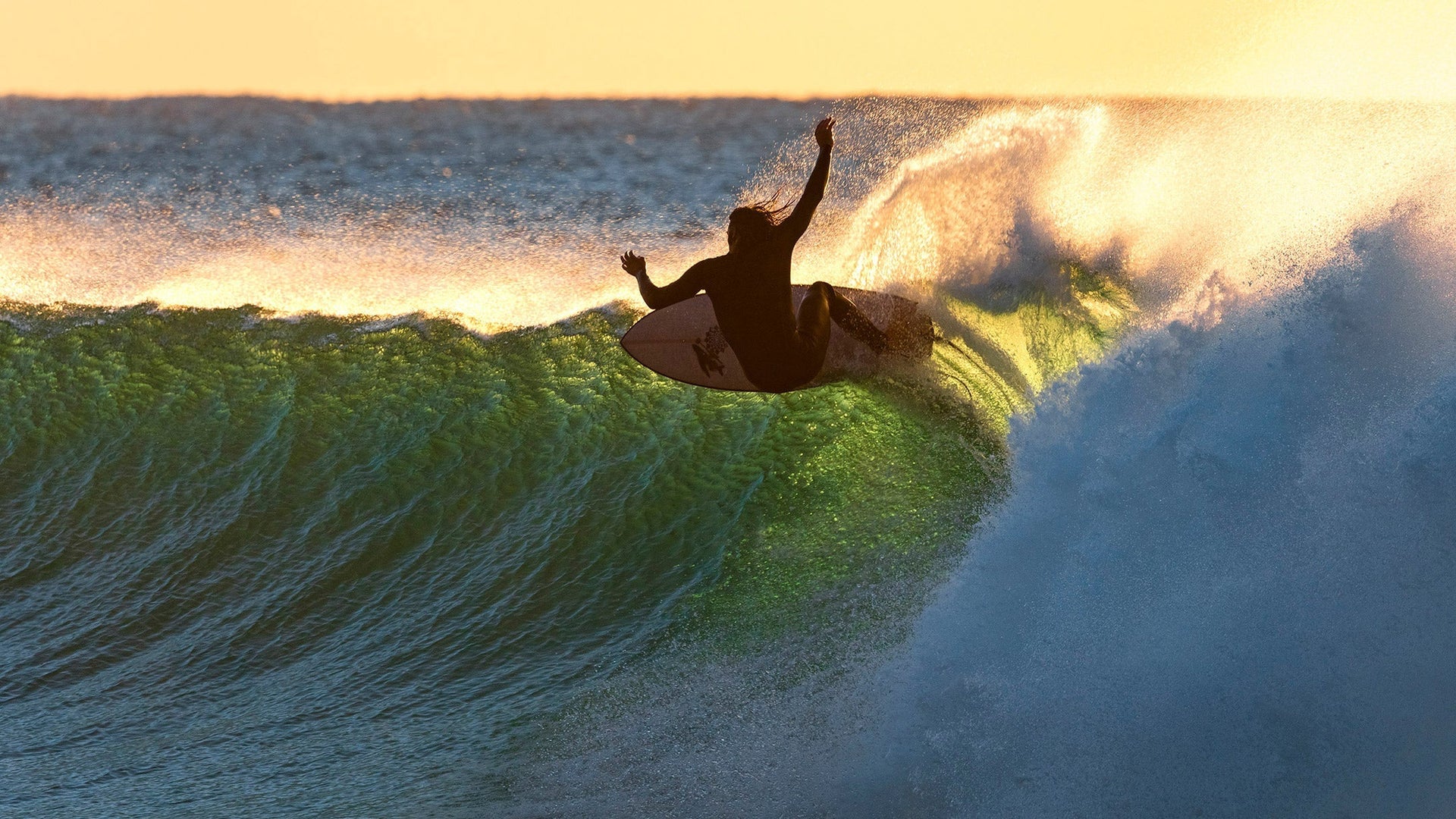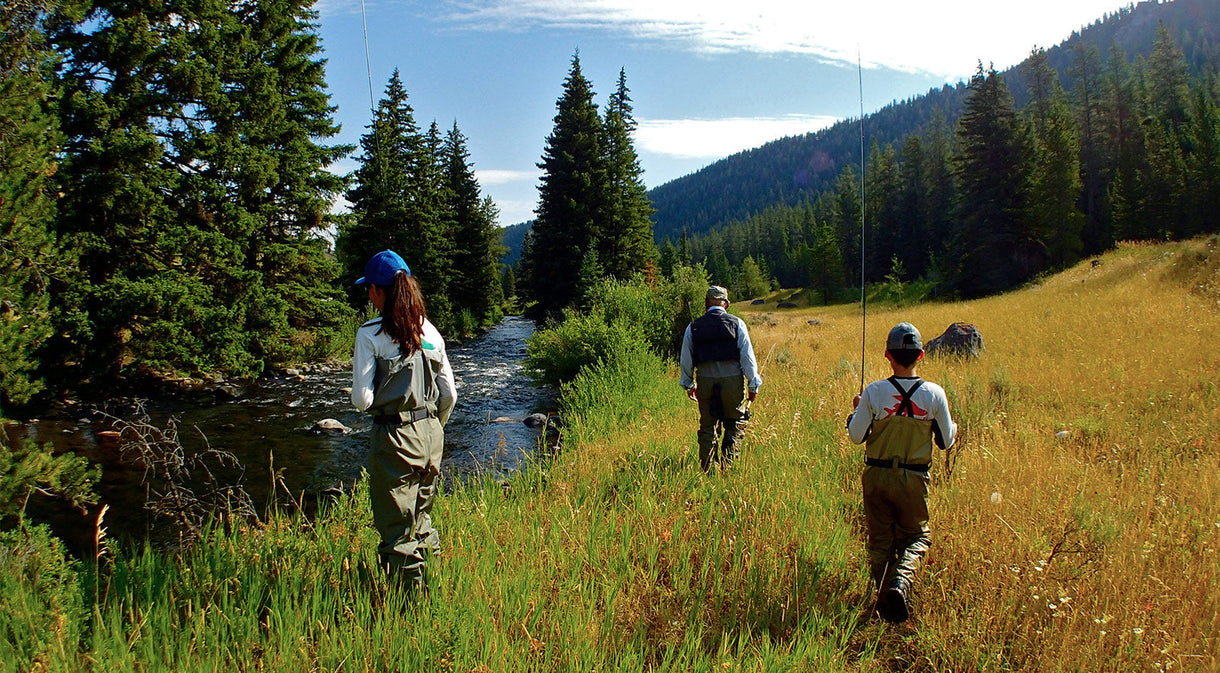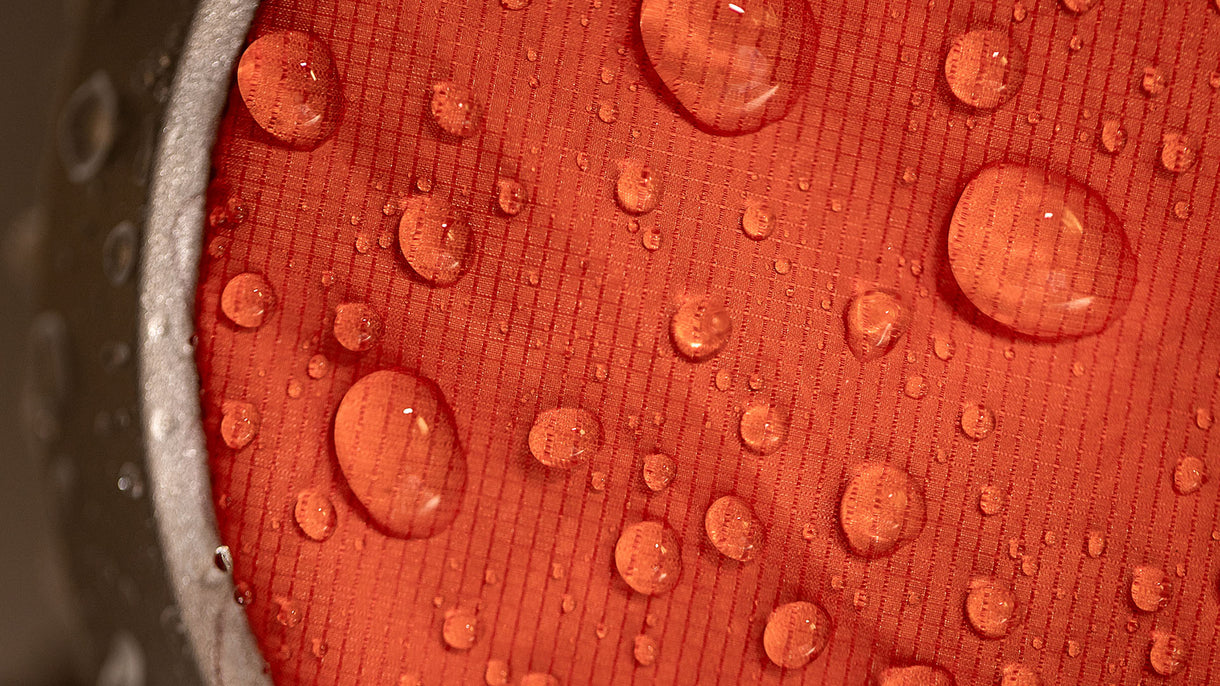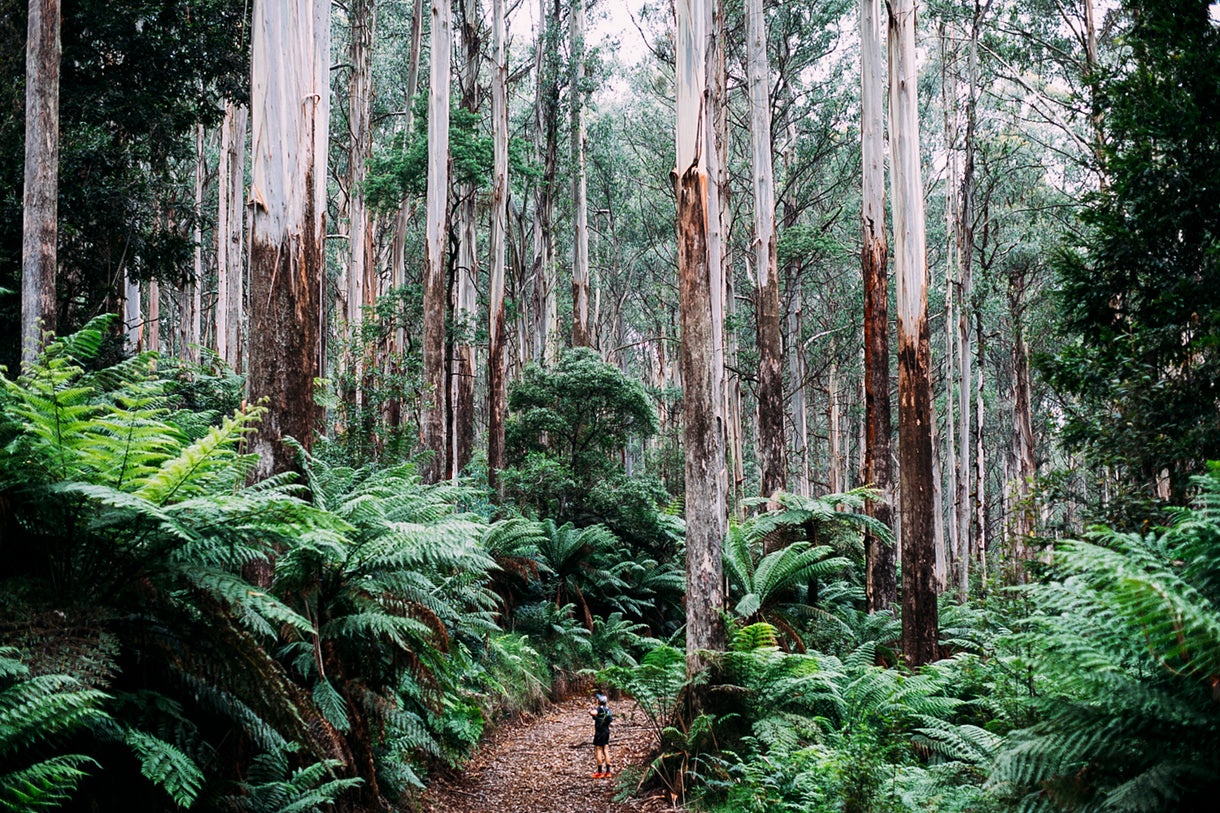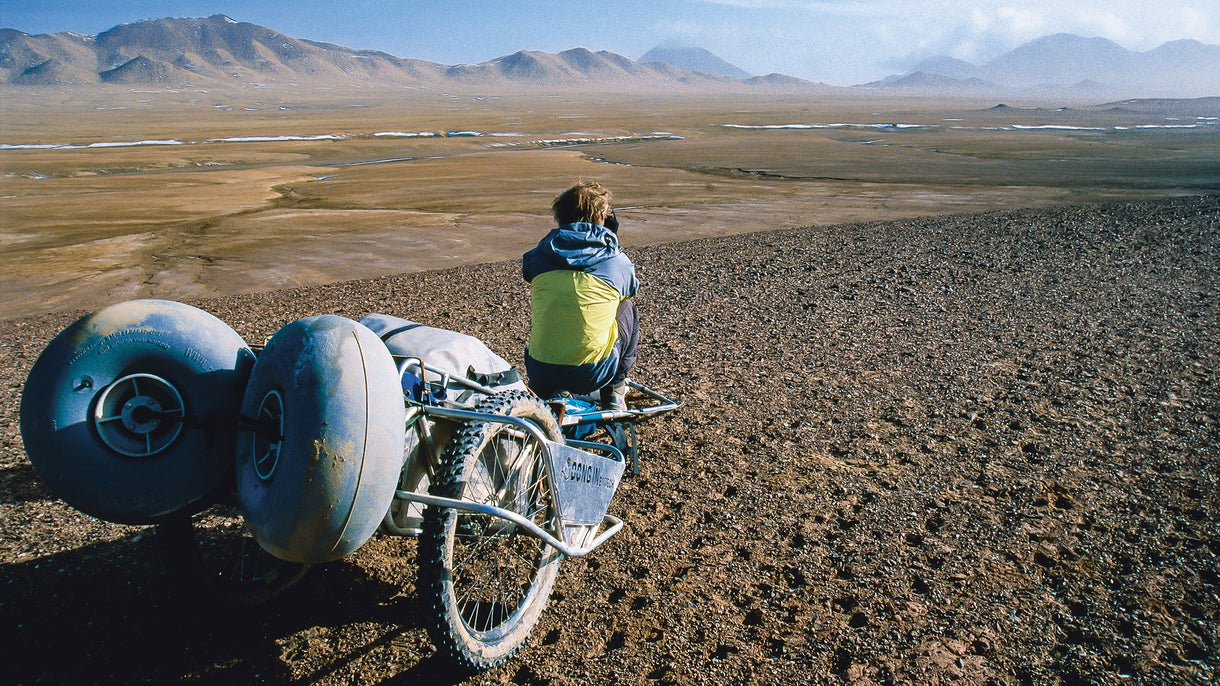Dave Rastovich and Greg Long log in and discuss the current state of surfing, its cultural and ecological impacts, and where it’s headed.
In Broken Head, Australia, surfer, activist, conservationist, and effortless-style archetype Dave Rastovich dials into our web call. He’s fresh off a travel-less autumn, going into winter, the whites of his eyes fried red after five days spent surfing the biggest swell to hit Australia’s southeastern coast in recent years. It’s 10:30 a.m. on Tuesday.
Moments later, Greg Long, Southern Californian surfer, activist, conservationist, and former Big Wave World Champ, buzzes in. He’s just returned to San Clemente, California (although these days, he spends most of his time at his home on the northern coast of Baja California, Mexico). He packed up his van and drove deep down into Baja during the early days of COVID-19, where he camped around the area for three months while the rest of the ex-pats headed north, home. It’s 5:30 p.m. on Monday.
“I wouldn’t have expected anything less from you, Greg,” laughs Dave after comparing notes on their recent whereabouts.
Dave hasn’t been on a computer “for more than a minute” over the past month, but took the time to link up with Greg for a two-hour conversation spanning the environmental and cultural effects of surf travel, eco-friendly surfboard materials, mass consumerism, where the surf industry is headed, the headspace of the youth and one of the best waves of Dave’s life.
“You want to start this thing off, being the elder statesman and all?” grins Greg.
Dave laughs. “What are you talking about?” he says. “I just turned 40. How old are you, Greg? Come on.”
“37, man.”
“Oh, shit! I blew that. Yeah, I got long, hairy Australian teeth; there’s no hiding my age right now. I’m a bit more haggard than your clean self. Although I’m sure after a while in the desert you’ve aged a bit too… Well, where would you like to kick-off then, Greg? What’s been lighting you up lately?”
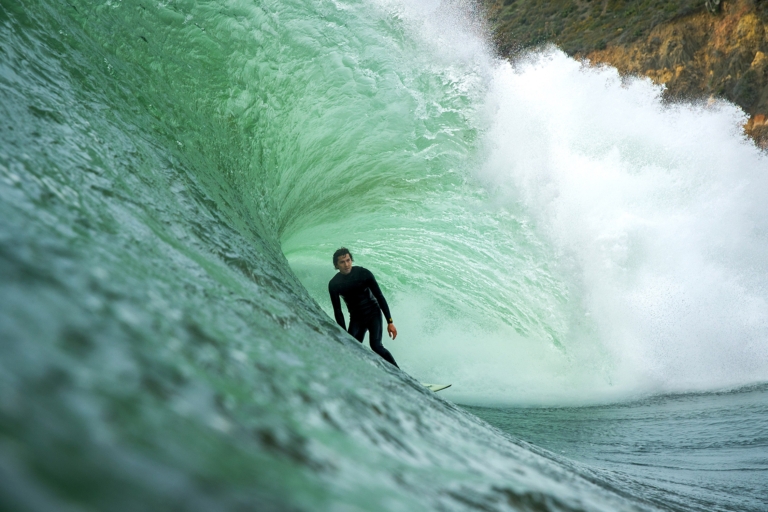 Greg Long all wrapped up in green somewhere in Mexico. Photo: Todd Glaser.
Greg Long all wrapped up in green somewhere in Mexico. Photo: Todd Glaser.
Greg: Let’s start with the great pause that’s been put on us in recent months. It’s been the first time in my life since I was 18 that I’ve spent a continuous three months in the same place with no thought of traveling anywhere other than to the beach or a little terrestrial trip up the coast. Taking the time to be completely still and contemplate the whirlwind of the last two decades, what that meant to me and the repercussions of it, was special.
Dave: Can you give me any examples of what you saw for the first time in an area of the world that you’ve visited a lot over the years? Were there any moments in particular where you were like, “Wow, I’ve been here X amount of times and I hadn’t seen or felt this new thing,” because of the change of pace and perspective?
Greg: Sitting in the same place for a month straight, we became so in tune with the tides and the other animals that called that area home. We came to recognize the same daily migration of a pod of whales that would make the same pass at nearly the same time each day. We got to know the birds nesting in the cacti nearby and how they interacted with each other. We watched ospreys hatch, fledge, and take their first flights. In past experiences, we would’ve noticed it less, focusing on where the waves were at.
It made me reflect on how I want to be traveling moving forward. By traveling that way, by planting [roots] someplace for long periods, it does have less of an impact environmentally, but it’s also a more enriching experience: to watch the transition of a whole season and become more familiar with the local flora and fauna, and people.
Dave: When you’re having an experience like that, you reflect on the ecological and cultural impacts of us coming into places with all this fancy surf gear and leaving almost as soon as we came.
Greg: In many ways, surf tourism can be a selfish endeavor. People on vacation show up to tap into a natural resource, whether it’s the waves or nature, without giving a lot of thought to the impact they’re having environmentally, culturally and socially, or to what they’re leaving behind. It’s a fact I’ve personally struggled with over the years of traveling and have done my best to mitigate.
There can be a lot of negative repercussions from an influx of tourism of any kind if the area’s infrastructure isn’t set up to support it. And sadly, a lot of places have changed, usually not for the better in my opinion, in order to cater to the materialistic behaviors and desires of the fast-paced westernised worlds. I think Bali is a perfect example of what can happen when that type of growth happens too fast. Bali has an incredible cultural and wave-rich environment, but the infrastructure was never set up to support the influx of people who flock there for tourism. That tourism put the area under a lot of duress and pressure, resulting in plastic pollution and some loss of local culture.
On a much smaller scale, but important nonetheless, I feel Skeleton Bay in Namibia could become an incredible example of how surf tourism could help benefit the ecological conservation of a region. A lot of professional surfers flock there for the big swells, get the waves of their lives, as well as footage and content to use for professional marketing purposes. Imagine if there was an organisation or fund set up that – if you are going to come and film professionally – asked you to contribute financially, or in some other way to help the conservation efforts in the area?
Now when I travel, I think about what might happen to an area if more surfers are going to be following in the coming years. I think a certain level of education is required on both ends of the spectrum: how a community can better prepare and benefit [from surf tourism], as well as education for the traveling surfers regarding what kind of behavior is acceptable and how they can truly give back and support the local community beyond just the few dollars they spent while passing through.
Dave: What about the project at that one amazing wave, where you’re getting in early with water sanitation and making sure there’s infrastructure for when a surf tourism boom comes to the area? What you’re doing there is on the leading edge of making sure surf travel has a conscience.
Greg: There’s an incredible wave we found in Africa, which is starting to become more known. It’s rather fickle but could easily see an influx of surfers like Skeleton Bay on the good days. I’ve been working on an experimental project with Twiggy [Grant Baker, South African big wave surfer] over the past few years that falls in line with what I was just talking about. We’re setting up an organisation where surfers can contribute, both financially or potentially with their time and work on different projects to help benefit the community. We have asked the locals in the community what they need and have tried initiating a series of projects ranging from beach cleanups to youth education and more. The basic idea is go and surf, have the time of your life, and support and give back to the local community.
I know in recent years you’ve stopped travelling almost altogether for a multitude of reasons.
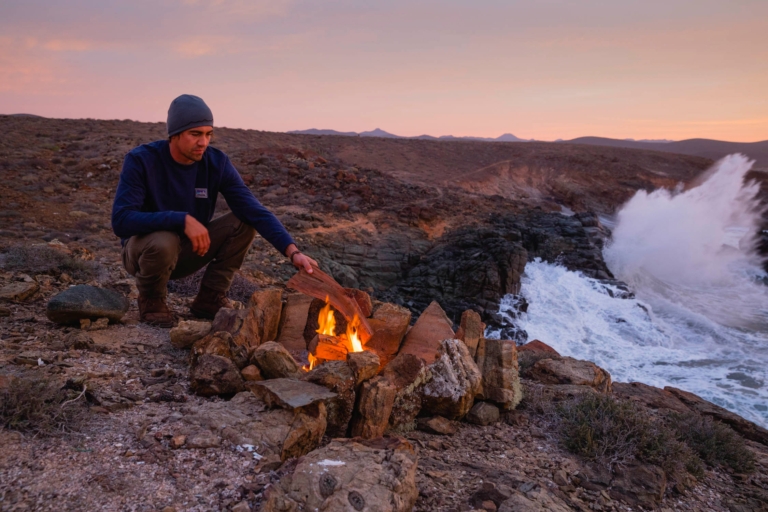 Greg Long’s surfed everything from Baja’s hallmark points to Todos Santos. In recent years, his vast knowledge of the region has led him to quieter—often empty—waves such as this little nook, which lies several hours off Highway 1. Baja California, Mexico. Photo: Al Mackinnon.
Greg Long’s surfed everything from Baja’s hallmark points to Todos Santos. In recent years, his vast knowledge of the region has led him to quieter—often empty—waves such as this little nook, which lies several hours off Highway 1. Baja California, Mexico. Photo: Al Mackinnon.
Dave: I remember talking to you about going to one specific wave a while back, my ideal wave type, and realising I probably just won’t get there – that I’ve already had quite a few years of surf travel, way more than my share. If I grow to an even older age than I am now, I’ll look back at how embarrassingly gluttonous my surfing life was in my 20s and my 30s. I have nephews in Australia who are mad surf rats, who have all these dreams of riding waves all over the world, and none of that is happening right now. They just finished school and are in their gap year, where they’re encouraged to travel before going into an institution of education. Rather than spreading themselves an inch deep and mile wide, they’re being forced to go an inch wide and a mile deep by localising. Localisation is a huge focal point for a lot of us right now. And I don’t mean a typically white fella localising a spot from other surfers. I mean the localisation of food, of economies and power, lots of different aspects – including localising our surfing life.
Which is easy for people in Australia to say: We live on this big island, where our entire continent’s population is about the same as Southern California’s. There’s so much space and good surf year-round. It’s peaceful and clean and it’s easy for us to not go anywhere and live a fulfilled surfing life. Which is a bit of a cop-out; it’s easy to stay home here. In recent years, I’ve gone to the US a couple of times to see some extended family with my partner and stopped in Hawai‘i because it’s brutal to fly to the East Coast with our little grommet. But other than that, we’ve been staying in Oz, for all of those reasons that you’re talking about. It’s a choice to say “no” to things, but it’s also a choice to say “yes” to what we do have in our area and discover how magical it is.
It seems like the honeymoon period for surfing is over, and we can have a good look at ourselves and think, “Has all that surf travel (or should we call it surf colonialism?) been a good thing? Did we need to jump on a plane to the other side of the planet for a three-day swell?” I think it’s a good thing to be talking about and questioning right now while we’re staying put in one place.
Greg: On the topic of questioning, I’m hearing you call it “your gluttonous 20s and 30s” of surf travel. But you were also one of the more influential surfers during that timeframe, who was questioning the status quo when it came to materials and the ethical construction and manufacturing of the products within our industry. We both shared the same sponsor at Billabong for years. The topics and conversations you were stirring up internally were really at the forefront of pushing the needle and asking that change be made. Fast forward 10 years: as far as materials and ethical practices go, what have you witnessed change within that time – from the conversations you were having and the way business was being conducted – to today?
Dave: I think anyone who has anything to do with surfing will look at the ’90s and 2000s as a very gluttonous period, where the corporations went Times Square status—Bong [Billabong] and Quiky [Quiksilver] had shops in the middle of Times Square, and if you look at the epitome of materialism and consumerism, it doesn’t get higher up the food chain. That was quite a troubling thing for me at the time, although a lot of people in the industry were like, “We’ve made it, man! We can all get money and live large and this is what everybody’s worked towards for decades….” I felt we were reaching a moral low point. We made all of this on the backs of other peoples’ and ecologies’ suffering, and there are no two ways about that. There have been exposés on sweatshops making wetsuits in Asia, and that was just very recently. If you look back to when there were fewer conversations about Fair Trade practices happening, all of those dollars were coming from the backs of other people’s suffering.
For me, the least I could do while I was part of that organism was to try and redirect some of our practices. Pushing organics in the line of clothing and recycled materials to lessen the pull of petrochemicals out of Momma Earth – I thought that was a good avenue to pursue. There was a time I was involved with Sea Shepherd [Conservation] Society, and was enjoying bleeding some funds off of the companies I was involved with that would typically go towards enlarging their profits; instead, they’d go towards grassroots organisations, and help communities in places we traveled, to balance the scales a bit. A lot of the times we failed; sometimes we succeeded. But it’s a completely different landscape now.
I’d say the three companies that were the pillars of corporate surfing – Quiksilver, Rip Curl and Billabong – don’t seem to be as present anymore. In Oz, you’re not seeing any groms wanting to sign up to that world and partake in the things they make. Small grassroots companies are popping up. This might seem like a plug, but in Australia people are getting behind Patagonia because there’s an actual honest attempt to do the right thing with the materials used and the treatment of those manufacturing the products. People here are excited about that.
The surf industry, where we are at right now, is so different. You got one branch of the tree – contests – and the other – print media – disappearing; it seems like the whole thing is dissolving and turning back into what it was in the ’70s, with smaller groups doing cool stuff and gorilla zines and mags popping up in communities. What we saw over here with the Fight for the Bight protests, people coming out in protest of Big Oil and in celebration of our coast – that’s 60,000 people, mostly surfers, willing to participate in activism, which has nothing to do with the old world of surf companies. I’m excited it’s such a different space now.
Greg: I couldn’t agree more. Captain Paul Watson [wildlife conservation activist/founder of Sea Shepherd Conservation Society], who I’ve had the fortune of getting to know through some work I’m doing, sums up what’s happening in our natural world succinctly. One of the basic laws of ecology, he says, is that any ecosystem has a limited carrying capacity of the life it can support. What’s transitioned in surfing in recent years falls within that – the surf industry tried to expand way beyond what could support it. Because of that expansion the surf industry started manufacturing cheaper products and mass-producing at too big a scale. It has to go back into a place where things are in balance, which is where we are getting to right now.
Dave: It’s a diversity thing too, isn’t it? Diversity is a fundamental law of ecology, and surfing was on a course to becoming a monoculture. It was one big company consuming another one, which then became one or two companies trying to dominate the space. It’s the same thing you see in agriculture – we have some sugarcane farming near where I live, and the diversity has been lost in those fields because there are one or two varieties of plants in acres and acres of space. I can’t help but think the surf industry was – and still is – in the same space as those sugarcanes, but it has an opportunity to branch out and diversify.
Greg: More so now than ever. Surfing has an opportunity to be purpose-driven; many of the new companies blossoming have a true identity and stand for something within whatever niche they are in. With this pause we’ve taken, and what I’m hearing from a lot of people, is that they’re looking for meaning behind what they’re doing and especially what they’re purchasing – not just frivolously squandering. They’re considering where and what they’re putting money and energy into, and whether it’s serving them instead of just fitting into the social narrative projected upon us by the media – the need for the latest styles because they’re cooler and look better and will impress your friends. There’s a greater level of community and connection, which weaves its way right into the surfing community at large. It’s a truly tight-knit culture and lifestyle that goes far beyond the industry with a connection to the ocean and the natural world. Hopefully, that’s a connection that carries on.
Dave: Here in Oz, we’re having record numbers of people in the water. Everyone is surfing; they’re pulling out their dusty board from the garage and shaking out an old wetsuit full of redback spiders and are like, “Fuck it. I’m going surfing. There’s nothing else to do.” Every lineup you can easily access is just chockers. But underneath that is a realisation of how much surfing means to us. It’s largely this free and blessed choice.
Before the pandemic, when the Norwegian oil company Equinor tried to extract oil from the Great Australian Bight in South Australia, prediction models showed a spill would wash up on all the surfable beaches in Oz and some in New Zealand. That activated a lot of the surfing population to participate in activism and conservation efforts.
And because of those efforts, Equinor pulled out of the Bight and so did BP and Chevron. Now the eye of surfing has shifted around the country to see what else is affecting our way of life. There’s gas exploration in Sydney, much like the gas exploration that’s going on in Santa Barbara and Southern California. We’ve got a government here that’s hellbent on Oz being an oil resource for the world. The actual population is quite engaged, educated and freaked out. We also just went through the gnarliest brush fires in our history, which were completely forgotten because of COVID. And now, surfers are like, “Hang on: surfing played a part in one of the greatest conservation events in Australia’s history just last year – we can become a force for balance! What’s next?” Maybe it’s the gas operation in Sydney, or planting kelp and seaweed farms to sequester carbon, or cleaning up our dirty rivers. It feels like we’re on the edge of a way to channel surfing’s energy and love for the coast into some good actions.
Fortunately for us in Australia, we have a system that’s looked after us enough where we can focus on ecology and each other’s well-being. It’s like this moral obligation: Our government looks after us medically and takes care of us if we don’t have a job; our basic needs are met. So now the community is thinking, “Let’s get busy making sure ecology is respected and looked after” – which is an insular view.
Greg: That is a really good point, and something I think is so important to take into consideration when addressing these global environmental challenges. In most of the developing countries and sadly, even some that we call “1st world” like the U.S., there are a lot of people struggling to simply get by, worrying about where their next meal is coming from or how they are going to pay rent or medical expenses. They simply don’t have the physical, emotional, and mental bandwidth to worry about such things and need to be met with compassion rather than judgement.
It was so amazing to see how the Fight for the Bight campaign started off as a grassroots movement more or less originating in the surfing community and quickly became a countrywide and then international campaign. It reminds me of a conversation we had a few years ago about how easy it is to become overwhelmed by challenges when you look at things from a global perspective. So rather than deflating your enthusiasm, homing in on what you can do in your local community is a good place to start. Don’t think about changing the world but just think about changing your own world.
With the recent growth in the number of people gravitating to the outdoors and the ocean, hopefully a deeper connection and respect for the natural world will be created and, in turn, a desire to take care of it. But playing devil’s advocate, I have to say with how busy beaches have been at home recently – and the influx of new people enjoying them – I am noticing a lot of neglect and more trash being left behind than ever before. The importance of continued education on how fragile these ecosystems are is more important than ever right now.
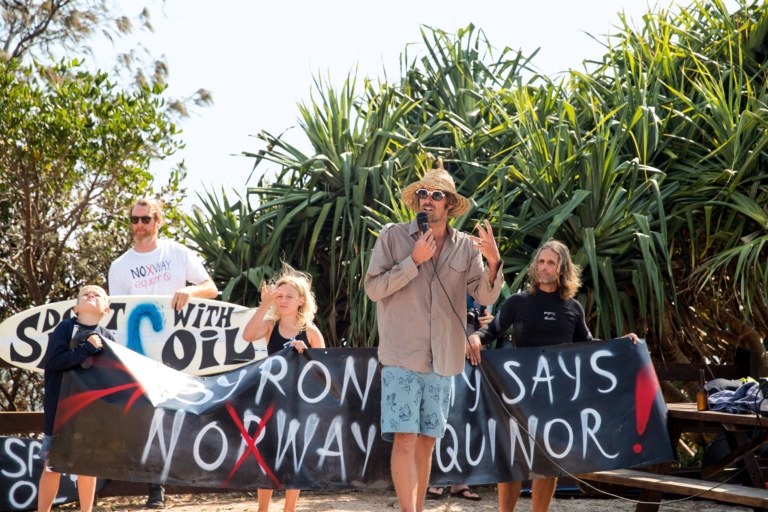 Dave Rastovich in Byron Bay, Australia, on Fight for the Bight National Day of Action, November 23, 2019. Photo: Jason Childs.
Dave Rastovich in Byron Bay, Australia, on Fight for the Bight National Day of Action, November 23, 2019. Photo: Jason Childs.
Dave: I think surfboards are an interesting area to explore, too. In Oz right now, a lot of people are buying boards with the recent rounds of government checks, and a lot of people are talking about what boards last and what don’t. It’s been an interesting time, because there’s been less media bombardment and less desire to buy the boards the pros on tour ride and boards from the mass manufacturers. A lot of local and backyard shapers are being supported by their community. Socially, that’s a great thing; ecologically, that’s a questionable thing, because people are turning to consumerism and buying a new board to be excited about surfing.
What’s interesting is some of the materials being used. One I’m excited about right now is the 5’7″ high-performance fish I’ve been riding from Gary McNeill; it’s a real blade of a board and it’s nearly five years old. It’s Marko Foam, which is recycled. It’s wrapped in flax fiber, and it’s sealed with bio-resin. It has the same springy flex it did when we made it – it has not creased or aged in any way. It’s the board I use most and I just can’t fault the thing. It’s started a lot of conversations about longevity and making things that last versus people not wanting to sacrifice performance for materials. But it feels like that conversation is changing too. Where people are like, “Ahh, I don’t give a shit if I don’t look like John John [Florence] or people riding those little wafers that break in a couple of months. I just wanna go fast, lay a turn here and there, and get barreled.”
If a board is made out of flax or timber


